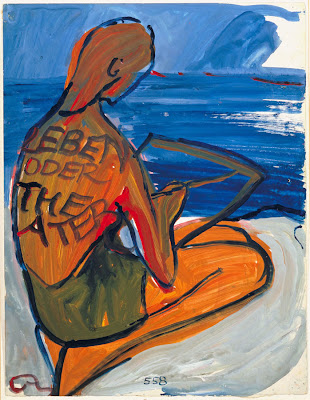 |
| Charlotte Salomon "Life or Theater" ca,.1940-43 Jewish Historical Museum, Amsterdam |
A family tragedy soon after her arrival, piled on top of the disintegrating political situation, seemed to spur Salomon on to produce her magnus opus, a set of 1,325 paintings and sheets of tracing paper, all of a uniform size: 32.5 x 25 cm (12.8 in x 9.8 inches.) In these paintings, drawings and musical notations, Salomon feverishly chronicled her life.
The work is a somewhat fictionalized autobiography detailing the main events of her life in the shadow of the Third Reich – her mother’s and grandmother's deaths, studying art despite discouragement, her relationship with friends and with her family – changing the names of the characters and infusing the account with a strong element of fantasy. Salomon called the work Leben? oder Theater?: Ein Singespiel (Life or Theatre? A Lyrical Drama) adding notes about appropriate music to increase the work's dramatic impact. In only two years, she painted over a thousand gouaches. She edited the paintings, re-arranged them, and added texts, captions, and overlays. It was recalled by friends and neighbors that she had a habit of humming songs to herself while painting.
 |
| Charlotte Salomon "Above Average" ca. 1940-43 Jewish Historical Museum, Amsterdam |
In 1943, as the Nazis intensified their search for Jews living in the South of France, she handed the work, two large bundles wrapped in brown paper, to the family doctor, who was active in the French Resistance, saying, “Please keep this safe, it is my whole life.” Charlotte Salomon, by now a young woman, had married another German Jewish refugee, Alexander Nagler. The two of them were dragged from their home in September 1943 and transported to a Nazi ‘processing center’ near Paris. Salomon was five months pregnant. She was transported to Auschwitz and was probably gassed on the same day that she arrived there (October 10, 1943.) She was 26 years old.
Following the war Salomon's artworks, which had miraculously survived, were returned to her father and stepmother, who donated the entire unique collection to the Jewish Historical Museum in Amsterdam in 1972. The work has had many major exhibitions and performances, and has been published in book format in a number of different editions.
 |
| Charlotte Salomon "Epilogue" ca. 1940-43 Jewish Historical Museum, Amsterdam |
From the Wikipedia entry on Salomon: "Life? or Theater? is intended as a Gesamtkunstwerk, a Wagnerian 'total work of art' within the tradition of the ambitious nineteenth century German idea to fuse poetry, music and the visual arts. Yet Salomon's work is a reversal of that tradition which was intended to be the ultimate manifestation of Germanic culture - instead it is a deeply moving and personal masterpiece, created by a 'young woman who belonged to a supposedly alien race and who was therefore held not to even have a right to exist, let alone a place in society.' [Norman Rosenthal, Royal Academy of Arts, 1988]
1 comment:
What an amazing story and so sad. To think her family thought her safe i France and her father and stepmother survived in Germany! ~SB
Post a Comment